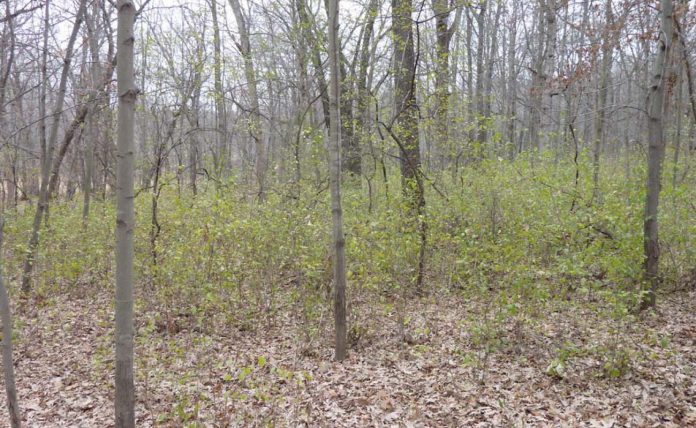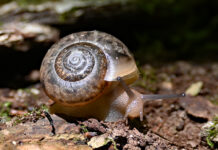
Common buckthorn (Rhamnus cathartica) and glossy buckthorn (Frangula alnus) are non-native, invasive plants originating from Europe/Asia. Buckthorn can be found throughout Ohio, but it most commonly occurs in the north, northeast and east-central regions of the state.
Introduced to the United States in the 1800s, Buckthorn was sold as an ornamental plant and for use in hedgerows.
Description
Buckthorn plants produce dark berries that are eaten by birds and dispersed across the landscape. These berries are diuretic and lack the nutritional value that berries from native plants contain. This can decrease the fitness of birds and other animals that eat the fruit.

Both species are tolerant of deep shade and full sun, making them extreme competitors with our native plants, often forming dense thickets, and displacing native trees and shrubs. A large shrub or small tree, both species of buckthorn will grow to 10′ to 25′ in height, taking on an oval form as they mature.
Glossy buckthorn prefers wet soils, while common Buckthorn prefers to grow in dry to moist areas. Glossy buckthorn leaves have a very shiny leaf surface, alternate leaf arrangement, smooth margins and eight to nine pairs of pronounced veins.
Common buckthorn leaves have a dull green leaf surface, opposite/sub-opposite leaf arrangement, three to five pairs of veins that distinctly curve towards the tip, and finely toothed margins.
There are several look-alikes that are out there including black cherry, chokecherry and black chokeberry.
Your local soil and water conservation district office can provide technical assistance to help you identify and control buckthorn on your farm. Buckthorn is problematic not only from a forestry/wildlife perspective but also agriculturally.
Common buckthorn is the alternate host to the crown rust fungus affecting oats, and is also the overwintering host for the eggs of the soybean aphid. In the upper Midwest, government incentives have been put in place to encourage the removal of buckthorn to help minimize the economic impact of the crown rust and soybean aphid.
Heading into late fall/winter, this is a great time of year to take a ride around your field edges and scout for buckthorn. Its green leaves persist into November/December and will stick out in your woods.
Treatment

According to the Ohio State University extension, a combination of mechanical/chemical control has shown to be one of the most effective methods for large plants or large stands of Buckthorn. A cut stump application of herbicide containing triclopyr, glyphosate, imazypyr or picloram at their recommended rates for this method are effective.
Be aware that imazypyr and picloram remain soil active much longer than triclopyr and glyphosate and thus may be taken up by the roots of nearby desirable trees and shrubs.
Smaller buckthorn plants can be controlled by hand pulling, using a weed wrench or by foliar spraying. Be sure to read the label of the herbicide to see if Buckthorn is listed as a species for control and follow the mixing instructions of the method you choose.
As always, be sure to read and follow the instructions found in the entire herbicide label, as the label is the law. If you have any questions, would like more information, or need a farm visit, contact your SWCD office.
Potential cost-share funding from federal farm bill programs may also be available to help you with the removal of Buckthorn. You can contact your NRCS field office or SWCD for more information on these programs.
A list of contractors who specialize in invasive species removal may be available upon request from the SWCD office or from your ODNR Division of Forestry Service Forester that covers your area.












